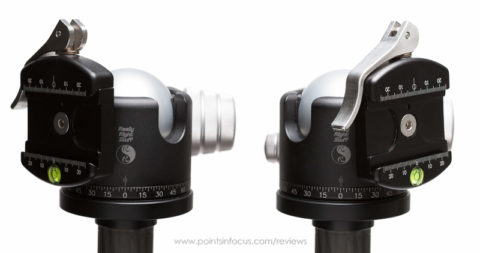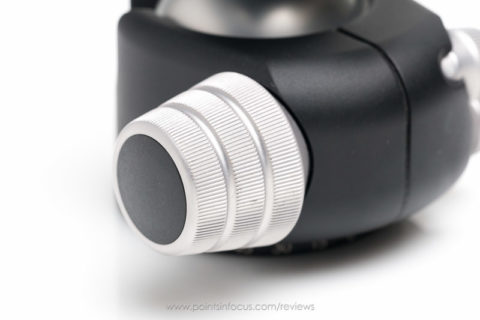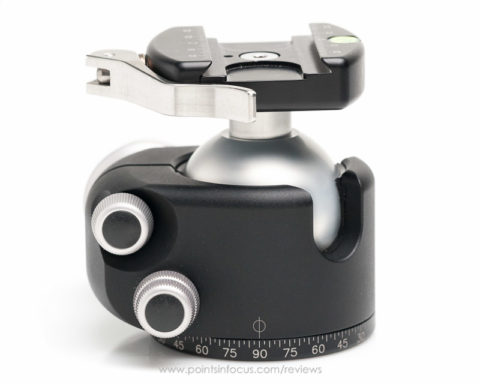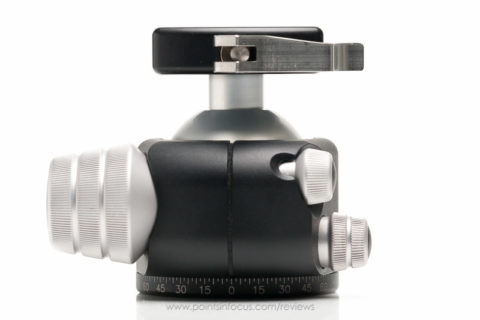Really Right Stuff BH-55 Ballhead Review
Tripod heads aren’t lenses, or cameras, there aren’t any easy benchmarks that can be used in an effort to objectively determine which is better or worse. Sure, you can objectively measure performance characteristics, such as torque resistance and weight, however the resulting numbers don’t always tell the whole picture, or even a necessarily accurate one. Instead, I think finding the right tripod head is about finding the head, and the right options, that’s the right fit for you as a photographer.
Consider the Really Right Stuff BH-55. By the published numbers, as given in the table below, the BH-55 isn’t even close to being the best ballhead in the class I’ve compared it. By the numbers, it’s the heaviest ballhead in the group, and has the second lowest rated load. By the numbers, I’d be a fool to switch from my Arca-Swiss Z1 to a BH-55. In practice, the BH-55 works better for me than the Z1 on a number of fronts—and it also appears to outperform my Z1 as well even if the numbers say it shouldn’t.
Build and Weight
The Really Right Stuff BH-55 isn’t the smallest or lightest ball head in its class—however you might define its class. This historically was the point where I dragged out some load to weight ratio and talked about how great or bad the head is for having such a good or poor load to weight ratio. I don’t really see a point in that anymore, even more so after actually testing the torques my BH-55 and Z1 could resist.
| Ball-head | Rated Load | Weight | ||
|---|---|---|---|---|
| Lbs | Kg | Lbs | G | |
| Arca-Swiss Z1 | 132 | 60 | ~1.5 | ~690 |
| Markins Q20 | 110 | 50 | 1.2 | 555 |
| Arca-Swiss B1 | 90 | 41 | 1.7 | 772 |
| Acratech Ultimate Ballhead | 25 | 11.4 | 0.72 | 327 |
| Kirk BH-1 | 50 | 23 | 1.9 | 850 |
| Really Right Stuff BH-55 | 50 | 23 | 1.9 | 862 |
So what can I say about weight? At 1.9 lbs. (864g) the BH-55 is heavier than any of the other heads on my list, and 25% heavier than the Arca-Swiss Z1 it replaced for me. Okay, so what? In practice, the difference isn’t especially meaningful. On the end of a Gitzo GT-3530LS tripod, both the BH-55 and Z1 shift the balance to the head end of the tripod. In a blind test, I don’t think I could tell the difference between the two by weight alone. Strap the tripod to a backpack and the weight difference is even less meaningful.
The BH-55’s socket and primary housing is finished with a slightly textured matte black coating. I like the slight texture a little more than the smooth finish of my Z1. The ball on the BH-55 is a very smooth matte silver color.
Unlike most ballheads, the BH-55 has two-drop notches instead of one. The two notches are set 45° to either side of the front-back axis. Since I use L-plates on my cameras, for me the drop notches are little more than a way to angle the camera up or down by more than the 45° allowed by the normal limitations of the socket.

In practice, I’m not sure how I feel about the dual drop notches. Since I use L-Plates, I hardly ever use them to actually allow me to take the camera to a vertical orientation. I want to say something like, “But since they’re not centered, it’s not as easy to simply point the camera down beyond 45-degrees.” However, since I had to run my Z1 with the notch facing the rear to get the tension/lock knob on the left side, I always had to rotate the Z1 180° to tilt the camera forward beyond 45° anyway. In the end, I don’t have a problem with them, though I can see how someone else might.
Controls and Usability
Really Right Stuff designed the BH-55 around separate controls for each of the main functions; ball lock, ball drag, and pan lock. All 3 of the control knobs are textured for grip, and have a texturing so they can be operated easily without looking.
The main control knob is the largest in diameter, as well as being located to the left side (when looking towards the drop notches), and has 3 separate sets of ridges.
The left side design of the lock knob is, in my opinion, the best choice from a usability perspective. With this configuration, you can use your lens hand to release and lock the head, without having to reach around the head for the knob.
The BH-55’s lock knob is optimized for quickly locking and unlocking the ball. As a result, there’s virtually no way to use the lock knob to adjust drag on the ball. Locking and releasing the ball requires only about a quarter of a turn on the lock knob, though it can be tightened down or loosened further. No more than a full turn is ever required, if that to insure the ball is locked fully.

There are two basic ways to use a ballhead, the right-drag method, and the unlock-adjust-relock method. I’ve always unlocked the ball before I adjust the camera, and then relocked the ball when I have the camera pointed where I want it. With that in mind, the fast action of the BH-55’s lock knob works really well in this respect.
One thing I’m always on the lookout for with ballheads is how accurately the lock the ball without shifting the image. Arca-Swiss’s claim with the Z1, that I used previously, was that aspherical ball would increase the drag as the camera was leaned over. In theory that sounds great if you’re a right-drag kind of user, since as the weight shifts more off center, the torque it applies to the ball increases, and so the ball has to resist more torque to keep the same feel for the drag.
In practice, I found that more often than not the drag didn’t increase enough to counter the increased torque from the off-center load to keep the apparent drag consistent. However, the real problem I had with the Z1 was that there was a small but noticeable shift in composition. I always attributed that to the aspherical ball, though I’ve certainly seen a similar effect in cheap ballheads as well.
The 55mm diameter spherical ball of the BH-55 has almost no shift when it’s locked down. If anything, the lack of shift in the head, and the stability of the head when locked down, really demonstrates how much play exists in the typical camera—both in the battery grip to camera body and camera to lens joints.

Drag on the BH-55 is set independently of the lock, using the drag set knob. The drag set knob is the top knob on the right side, and can be distinguished by feel as it only has unbroken ridges. As I noted, I’m not a big user of drag on my ballheads. The right-drag technique relies on dialing in enough drag that the camera won’t move on its own, but not so much that you can’t push or pull it around to where you want it.
Unfortunately, if I had to level a complaint at the BH-55 it’s that the drag set screw isn’t fine enough. On my BH-55, the usable range on the drag screw is somewhere between 0 and 2 or 3. At 0, there’s no drag at all, and by 2 or 3, there’s almost so much drag that it becomes hard to manipulate most sub-200mm lenses. Admittedly, I haven’t tried putting a very heavy lens, like a 500mm f/4, on the BH-55, in which case a higher drag number may be needed. In any event, I would have liked to see a finer adjustment range.
The final control is the lock knob for the pan base. The control is located below the drag set knob, and is differentiated by feel as having a split down the middle of the ridges. Locking and unlocking the pan base requires about a half turn of the pan lock knob, though its small diameter makes this comparatively speedy, as you can just twirl in between your fingers.
The moving portion of the base is marked at 90° increments with indicators. The rear position isn’t marked as such, but that position is indicated by the split in the casting and is at least accurate enough for simple alignments. For anything requiring alignment that is more precise, you’ll definitely need to use either the side or front indicators.
The fixed base is marked in 2.5° increments, with larger marks every 5° and the angle written out every 15°. The scale is laid out from 0° to 90° then back to 0°. I do like having actual degrees marked out better than the Arca-Swiss Z1’s scale which just used dots every 5° with a line every 15°.

Capacity
The capacity of a ballhead is an interesting topic. What does it mean and how much is enough? More importantly how is it tested, and why should I care about a load in pounds?
Most manufacturers provide capacity information in the form of a weight. Really Right Stuff rates the BH-55 as having a capacity of 50 pounds. But what exactly is that supposed to represent? That’s a good question, and one I can’t answer.
The BH-55 is a ballhead, which means it’s a solid metal ball sitting in a solid metal socket, on top of a solid metal pan base. Put a load in excess of 50 pounds on the top and what exactly is going to fail and how? The socket part of the ball head is certainly far thicker than a 50-pound load would break. The lock bolt should easily resist more than 50 pounds in tension as well.
Even if you kick the load off center, there is certainly far more material in the stem and the bolt holding the quick release clamp to the ball’s stem is certainly capable of resisting more than 50 pounds in tension or shear.
Weight, as a measure of ballhead capabilities seems to be of little meaning to me. The interesting question is, how much weight can the head hold without rotating, we call that force torque. Unfortunately, of all the manufacturers only Markins publishes torque ratings for the heads.
Since I consider the real relevant measure of performance with a ballhead to be its ability to resist torque I elected to do a rudimentary test on the BH-55 and Z1 instead of relying on published numbers. There’s certainly room for error in this test setup. I merely bolted a 2×1 to a Arca-Swiss lens plate, then loaded it with a 5 pound (2.25kg) weight the increased the distance between the weight and the head until the head started slipping. I would point out this isn’t nearly as scientific as it could be, and I wouldn’t attempt to directly compare these values to published values. Moreover, since I don’t have a good way to set a repeated lock tension, there results aren’t perfectly invariant between tests.
| Tripod Head | Distance | Torque Limit (approx.) |
|---|---|---|
| Really Right Stuff BH-55 | 18” (0.457m) |
147 inch-pounds (16.805 N*M) |
| Arca-Swiss Z1 | 12” (0.305mm) |
118 inch-pounds (13.39 N*M) |
There’s definitely some room to improve in the torque testing area, and I may go about doing that in the future to get a more comprehensive idea about the performance of these tripod heads. However, since both of these heads are capable of holding well in excess of what your typical camera load will place on them, I don’t see a practical reason to rush to more sophisticated testing as of yet—doubly so as I’m not really interested in breaking anything either.
Is 100-200 inch-pounds good enough? Practically speaking, it’s more than enough to hold a 500/4 and a pro body stable at any angle. Practically speaking, it’s more than enough to show you just how much flex there is in stacked teleconverters or multiple lens adapters. In short, I certainly think so and I think it’s good enough with quite a bit of margin.
Final Thoughts
Really Right Stuff offers the BH-55 in a number of configurations varying the type of quick release clamp, including a base model that has no quick release clamp or platform at all. Clamps mount to the BH-55 using a 1/4-20 mounting screw. Factory options include screw-knob and lever action clamps, as well as screw-knob and lever action clamps on a secondary pan base.
I can’t really say whether there are better options than the BH-55 on the market, or even whether the BH-55 is the right ballhead for you. For my purposes, pros significantly outweigh the cons, and overall I find the BH-55 to be a better solution for me than my Z1 was. Unfortunately, the biggest hurdle with a lot of this stuff, is simply finding what works.
Unfortunately, Really Right Stuff doesn’t have a retailer network, so there’s no easy way to go put hands on their products prior to purchase. They do offer a 30-day return window, so long as the product isn’t damage and doesn’t show signs of wear, though admittedly generous return policies don’t make trying out various alternatives any easier.
Perhaps a better way to put it, is would I recommend a BH-55?
Honestly, yes. I’ve found very little that I can fault it on, at least for my uses. That said, the drag settings are touchy enough that if I frequently used them instead of the lock knob I might feel differently.
Really Right Stuff sells direct, and I don’t get anything for referring you. If you’re interested in the BH-55 visit Really Right Stuff to buy or for more info.
Comments
There are no comments on this article yet. Why don't you start the discussion?